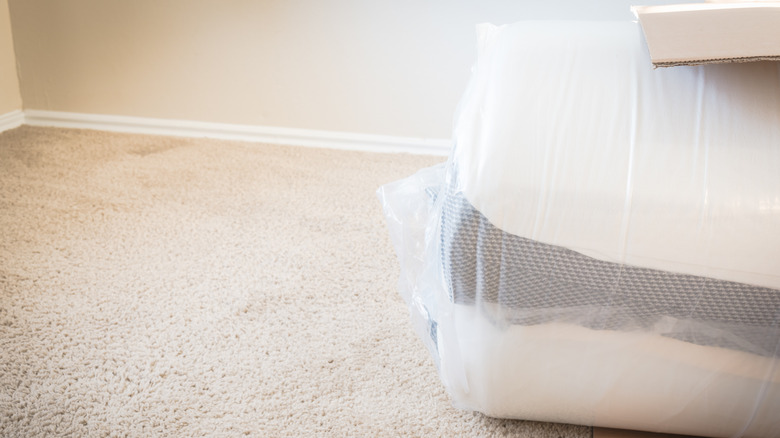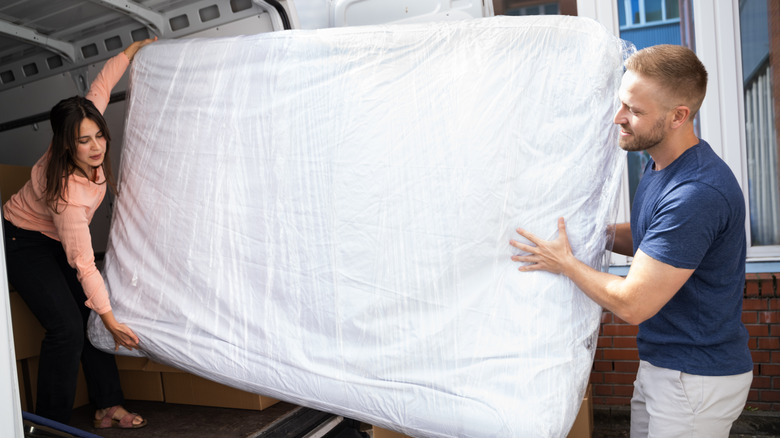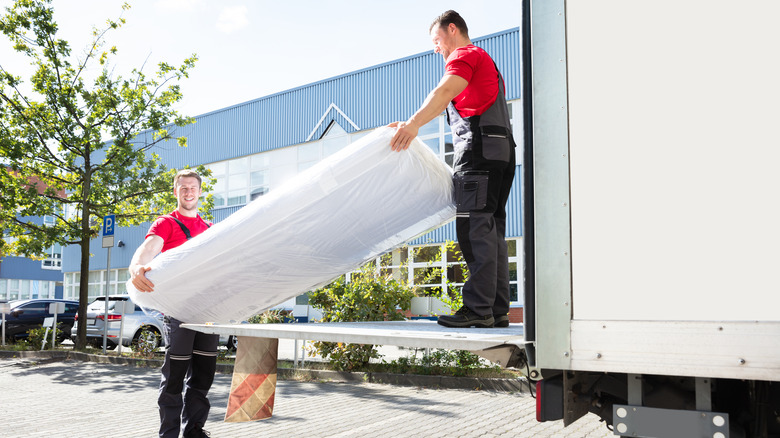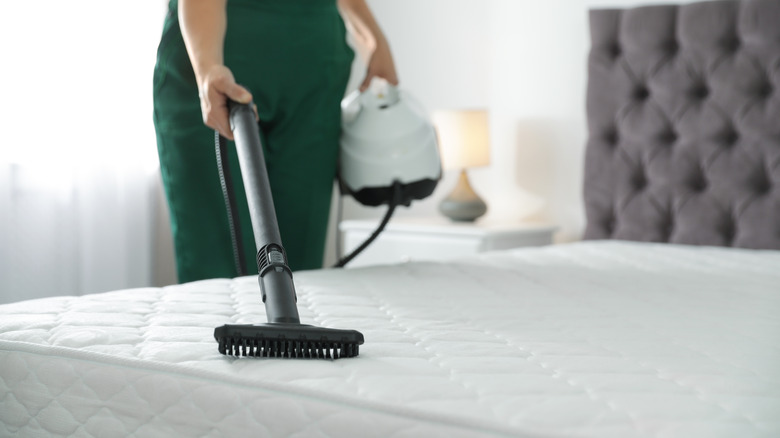4 Tips For Moving With Your Mattress Without Damaging It
Moving to a new home can be an uncomfortable process, especially when that involves leaving your hometown, state, or even country. This is why it's imperative that you bring your comfort with you by safely transporting your mattress to your new home. Depending on your situation, the process of transporting your mattress to your new home can range in difficulty due to its awkward shape and bulky size. Luckily, there are plenty of simple things you can do to make the process easier. For example, Casper mentions that bringing in the help of a friend can make the biggest difference when it comes to moving your mattress.
So, if you happen to be approaching your moving day and still have no idea how to tackle the difficult process of moving your mattress, let us assist you with a variety of tips that can help you easily and safely transport your mattress to your new home. Let's take a closer look at 4 of these tips and demonstrate how to use them to protect and transport your mattress during your next move.
1. Packaging
Before even attempting to move your mattress out of your home, Casper highly recommends first placing it into a mattress bag. Regardless of if you decide to transport your mattress in your own personal vehicle or a loaned moving van, your mattress will be exposed to a number of dirty environments that could affect the quality of your mattress and possibly the quality of your sleep. According to Casper, purchasing a mattress bag is not a major investment. In fact, they only cost between $10 and $25 and can be purchased in various local stores, including Walmart, Target, and Home Depot. If you are looking for a specific mattress bag that allows you to flatten and roll you mattress together to save space in your car or moving van, your local Walmart is sure to also have plenty of vacuum bags to choose from (per eachnight).
To put your mattress into a mattress bag, grab a partner and start by laying your mattress against a surface, preferably on a floor or wall. Then, as one person lifts up one side of the mattress, the other person should pull on the mattress bag to cover the mattress. Once the entire mattress fits snuggly inside the bag, push out any extra air before sealing the bag tightly.
2. Moving a mattress
Once your mattress is properly stored in its protective packaging, your next step is to physically move your mattress. If you purchased professional movers to help you with this task, this step will be easy for you. If not, you must first ensure you have a clear path to where you will be moving your mattress. PODS specifically mentions moving away valuable and breakable items that could fall and break as you attempt to move your mattress.
To move your mattress, PODS high recommends leaning it on its side. Not only will this allow your mattress to slide through small openings, like doors, but it will also be much easier to move in general. If you are having difficulty picking up or sliding the mattress across the floor, a furniture dolly can also come in handy. Although there are dollies specifically made for moving mattresses, these can be rather hard to locate; therefore, a four-wheel furniture dolly may be the next best thing. Renting or purchasing a four-wheel furniture dolly also allows you to use the tool for more than just your mattress, like other heavy household furniture pieces or boxes. If renting or purchasing a dolly is not an option, PODS states that using a piece of cardboard underneath your mattress can also help it easily glide across the floor.
3. Loading a mattress
When you are ready to load your mattress onto your moving vehicle, The Sleep Judge shares that the vehicle you are using to transport your mattress highly dictates the specific way you need to load and position your mattress. For example, if you are planning on using a moving van or truck, you can easily place your mattress flat on the floor or against the side of the vehicle if the space is available.
If you are transporting your mattress with a pick-up truck, the best way you can position your mattress for transportation is flat inside the bed of your truck. If the mattress is too large to fit directly into the bed, it can be leaned to one side with the tailgate down as long as it remains properly secured for the duration of your travels. If you plan on using your pick-up truck to move more than just your mattress, it is advised not to place anything above or under the mattress to prevent the mattress bag from being punctured or torn.
Finally, if you plan on using a regular car to transport your mattress, the best place to secure the mattress is on the roof using the luggage racks. Before committing to this type of transportation, however, you must ensure your mattress is not too big for your car and understand the risks of transporting your mattress in this exposing way.
4. Storing a mattress
If for some reason, you can't take your mattress along with you to your new home right away, Saatva shares a simple way you can prepare and store your mattress until it is ready to be used again. First and foremost, before packing up your mattress for storage, it must be thoroughly cleaned and aired out. To do this, you need to remove all the sheets and bedding on the mattress, then sprinkle the surface with baking soda and let it sit for about 8 hours to allow the baking soda to absorb all the mattress's odors. When the time is up, vacuum up all of the baking soda and let the mattress air out for an additional few hours. For some extra cleansing, you can also stick your mattress outside in the sunlight, which allows the ultraviolet rays to absorb even more odor.
Before storing, you need to tightly cover and secure your mattress with a mattress bag and packing tape. For extra protection, it is advised to double-up on the mattress bag, especially if you plan on storing your mattress for an extended period of time. Finally, when finding a place to store your mattress, whether it's inside a home or in a rented storage unit, ensure the area is at the very least free of mold and mildew to ensure that your mattress will last until it is needed again.




